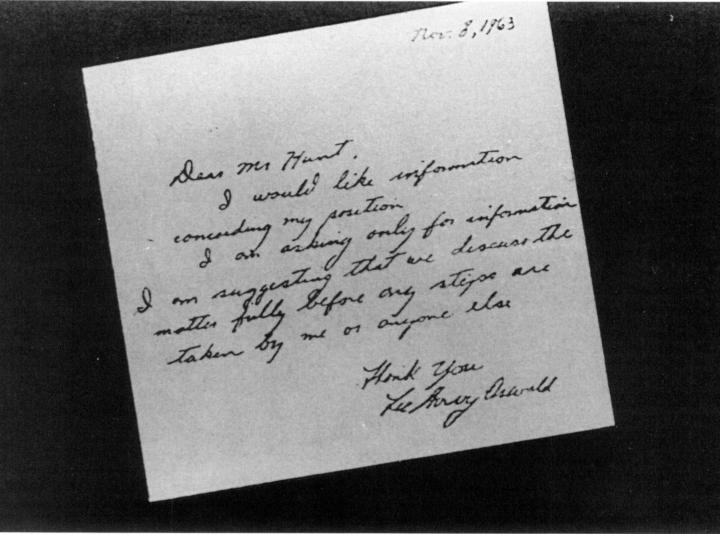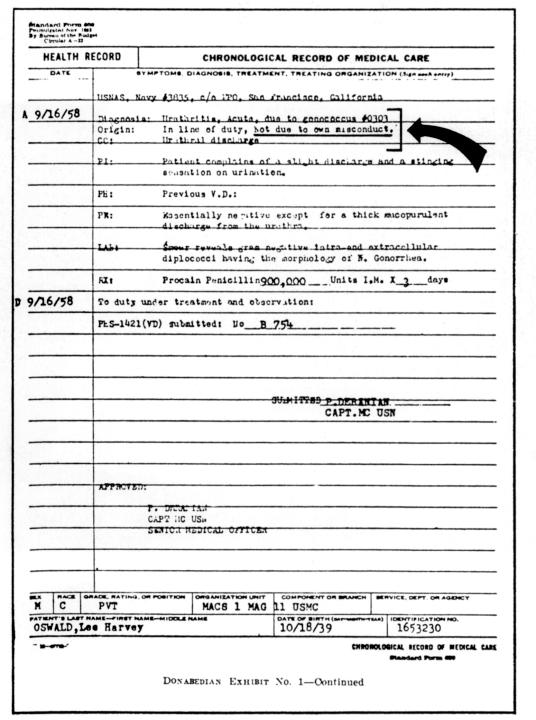Crossfire: The Plot That Killed Kennedy (66 page)
Read Crossfire: The Plot That Killed Kennedy Online
Authors: Jim Marrs


PENN JONES JR.
This handwritten note dated November 8, 1963, and signed Lee Harvey Oswald is
addressed to a "Mr. Hunt" asking about "information concerding (sic) my
position." The handwriting has been authenticated as that of Oswald. Some
researchers believe the addressee may have been Dallas oilman H.L. Hunt.
However, due to the fact that a copy of the note came from Mexico City, other
researchers believe the addressee may have been Watergate scandal figure E.
Howard Hunt, a CIA officer working with anti-Castro Cubans in 1963. By some
accounts, Hunt was in Mexico City about the time the note was written. A CIA
memo recently made public indicates that Hunt may have been in Dallas on the
day of the assassination, an allegation Hunt steadfastly denied.

Texas military intelligence units that normally were used to augment
presidential security preparations were inexplicably told to stay home on
November 22, 1963.
Col. Fletcher Prouty has reported that the 112th Military Intelligence
Group at 4th Army Headquarters at Fort Sam Houston was told to "stand
down" that day rather than report for duty in Dallas, over the protests of
the unit commander, Col. Maximillian Reich. While apparently some
elements of the MI unit did arrive in Dallas, their activities there remain
obscure. One member may have been with FBI agent James Hosty the
morning Kennedy was killed. In Warren Commission testimony, Hosty
said that forty-five minutes before the assassination he was in the company of an Army intelligence officer, but he added the meeting had no
connection with Kennedy's visit.
Recall that Agent Hosty's name, address, phone number, and license
number were found in Lee Harvey Oswald's personal notebook (this was
originally deleted from the material turned over to the Warren Commission) and it was Hosty who destroyed a message from Oswald days after
the assassination apparently on orders from superiors.
Another Army intelligence officer to become involved in the assassination was Special Agent James Powell. Carrying a 35 mm Minolta camera,
Powell had taken several photos in Dealey Plaza at the time of the
assassination. He entered the Texas School Book Depository and his
presence became public knowledge when he was forced to show his
identification after Dallas police sealed the building. Powell told researcher
Penn Jones he "worked with the sheriff's deputies at the rear of the Texas
School Book Depository for about six or eight minutes" and that he had
ordered a newsman to hang up a telephone on the building's first floor so
that he (Powell) could use it.
No meaningful investigation has been made by the government to
determine what intelligence agent Powell was doing in Dealey Plaza at the
time of the assassination.
And the military connection becomes even more curious in light of two
strange incidents that occurred in Dallas that day.
Dallas police lieutenant Jack Revill told the Warren Commission that an
Army intelligence officer rode with him from Dealey Plaza to the Dallas
Police Station. It was Revill, as head of the police criminal intelligence
division, who submitted a list of Texas School Book Depository employees. Leading Revill's list was the name "Lee Harvey Oswald," with the
address given as 605 Elsbeth in Dallas.
Oswald had lived at 602 Elsbeth in late 1962 and early 1963, but had
since moved, and the Elsbeth address had never been given to his employers at the Depository. Where then did Revill get the Elsbeth address?
It was later revealed that the 112th MI Group, which maintained an
office in Dallas, had possessed a file on a man named "Harvey Lee
Oswald," identifying him as a procommunist who had been in Russia and had been involved in pro-Castro activities in New Orleans. This military
file erroneously gave Oswald's address as 605 Elsbeth, the same mistake
found on Revill's list.
Apparently military intelligence was swift in providing Dallas police
with information on Oswald, the man who came to be labeled as the lone
assassin of Kennedy.
Information on Oswald apparently came from the 112th MIG's operations officers, Lt. Col. Robert E. Jones, who was stationed at Fort Sam
Houston in San Antonio. Testifying to the House Select Committee on
Assassinations, Jones said the afternoon of the assassination he received a
call from his agents in Dallas advising that a man named A. J. Hidell had
been arrested.
Jones said he began a search of his intelligence indexes and located a
file on A. J. Hidell that cross-referenced into one for Lee Harvey Oswald.
He said he then contacted the FBI in both San Antonio and Dallas with his
information.
However, nowhere in the vast documentation of Oswald's life did he
ever actually use A.J. Hidell as an alias-the exceptions being when he
mail-ordered the rifle allegedly used to kill Kennedy and the pistol allegedly
used to kill Officer Tippit using the name Hidell and the use of the name
Hidell on Fair Play for Cuba literature.
This raises two possibilities. Either military intelligence had some independent knowledge of Oswald's purchase of the weapons which took place
long before he arrived in New Orleans (were they monitoring his Dallas
post office box?) or someone, perhaps even Oswald himself, informed the
military of his purchases.
The files on Hidell and Oswald gave detailed information about Oswald's
trip to Russia as well as pro-Castro activities in New Orleans. Jones said
he had become aware of Oswald in the summer of 1963 when information
had been passed along by the New Orleans Police Department regarding
his arrest there. He said the 112th MIG took an interest in Oswald as a
possible counterintelligence threat.
The House committee, remarking on how quickly the military found
files on Oswald, stated:
"This information suggested the existence of a military intelligence file
on Oswald and raised the possibility that he had intelligence associations
of some kind."
The Warren Commission specifically asked to see any military files
regarding Oswald but were never shown the files mentioned by Jones or
any others.
In 1978, when the House Select Committee on Assassinations learned of
these files and requested them from the military, they were told the files
had been "destroyed routinely" in 1973.
The committee concluded:
The committee found this "routine" destruction of the Oswald file
extremely troublesome, especially when viewed in light of the Department of Defense's failure to make the file available to the Warren
Commission. Despite the credibility of Jones' testimony, without access
to this file, the question of Oswald's possible affiliation with military
intelligence could not be fully resolved.
Even more troublesome is the military's file on A. J. Hidell. Jones
stated that Hidell was an alias used by Oswald, which accounted for the
fact that the two files were cross-indexed.
It appears that the U.S. military knew more about Oswald and his
weapons than has yet been made public. But does that mean the military
ordered the assassination?
It is ironic that of all our modem presidents, it was John F. Kennedy
who received the only full military funeral in recent history.
Was this the military's way of making atonement?
While the U.S. military has attempted to keep a low profile in modern
American life, there can be no question that the military-industrial complex is a force in the nation.
Obviously military and intelligence officers did not take kindly to
Kennedy's attempts to restrain this powerful conglomeration. Kennedy
angered these men by refusing to use U.S. military power to salvage
the Bay of Pigs Invasion. Then he added fuel to the fire by rejecting
recommendations by the joint chiefs to bomb the missiles emplacements
in Cuba and to refrain from signing a nuclear test ban treaty with the
Russians.
Vietnam may have been the straw that broke the generals' philosophic
back. Viewed from the broadest perspective, it now seems possible to state
that the opening shots of the full-scale war in Vietnam were in Dallas,
Texas. Much evidence exists that Kennedy would have disengaged this
nation from Southeast Asia had he lived-again in direct conflict with the
wishes of the military-industrial complex.
Some generals-including Dallas mayor Earle Cabell's brother, Gen.
Charles P. Cabell-even went so far as to brand Kennedy a "traitor."
Cabell, after being fired by Kennedy as deputy director of the CIA,
resumed responsibilities in the Pentagon.
The known connections between the military and the assassinationare many and troubling.
All this-along with the mysterious disappearance of military files on Lee Harvey Oswald, who had many opportunities to work with military
intelligence-makes many assassination researchers believe that at least
some members of the U.S. military may have played a role in an assassination conspiracy.
If you didn't see Lee Harvey Oswald up in the School Book Depository with
a rifle, you didn't witness it.
-FBI agent to witness Richard Carr
Aftermath
Dallas
The gunfire had barely died away in Dealey Plaza when an aftermath of
odd and often unexplained events began in Dallas-and continued for
more than two decades.
Dallas police blocking the nearby intersections-with no orders to the
contrary (recall the eight-minute disruption of the Dallas police radio
motorcade channel during the time of the shooting)-released traffic that
began pouring through Dealey Plaza.
Spectators from blocks away, having heard the shots and sirens, ran to
the scene. Some bystanders were in shock. Others were shouting, "They
shot the President!" while others sobbed out the news. Pandemonium was
the order of the day.
There was no shortage of lawmen as nearly twenty sheriff's deputies,
following Sheriff Decker's orders, ran to the railroad yards behind the
Grassy Knoll. Dozens of Dallas police officers also were flooding the area.
But all were receiving conflicting information-witnesses on the west end
of Dealey Plaza pinpointed the picket fence on the Grassy Knoll as the
source of the shots, while many people on the east end said shots came
from the Texas School Book Depository.
It is significant to recall that James Tague, who was slightly wounded when
a bullet or bullet fragment struck the Main Street curb near the Triple Underpass, last spoke with Deputy Sheriff E. R. Walthers before having to move
his car once traffic got moving. Tague said this occurred about 12:40 P.m.
Yet Walthers was among the first officers to seal off the Depository,
indicating that the building was open for at least ten minutes after the
shooting.
Actually the time may have been much longer. Dallas Police Captain
Will Fritz, who headed the Dallas investigation, told the Warren Commission he began making detailed notes after hearing of the assassination at
the Trade Mart. Fritz said he arrived at the Texas School Book Depository
at exactly 12:58 P.M. Asked if the Depository exits were guarded at that
time, Fritz replied: